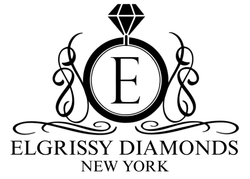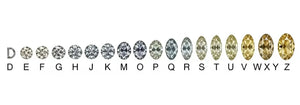Ever wondered why some diamonds sparkle brighter and appear whiter than others? Or why two seemingly similar diamond rings can have such different price tags? The answer lies in the diamond’s color, one of the key factors influencing its beauty and value. In the world of diamonds, color is part of the famous 4Cs (cut, color, clarity, carat), and understanding the diamond color scale can empower you to make an informed choice. Let’s dive into this dazzling world, guided by the standard set by the Gemological Institute of America (GIA), the gold standard in the industry.
What Is the Diamond Color Scale?
The diamond color scale is a system that evaluates how close a diamond is to being colorless. The less color a diamond has, the higher its value. The GIA developed a scale from D (completely colorless) to Z (light yellow or brown), which has become the global standard for assessing diamond color.
Key Note: This scale applies only to white diamonds. Diamonds with vivid hues, like pink, blue, or green, are called fancy colored diamonds and are graded on a different system.
The scale starts at D, representing colorless diamonds, and ends at Z, where a light yellow or brown tint is noticeable. The differences between grades can be so subtle that they’re often hard to detect without professional equipment.
The GIA Color Grading System
Let’s break down the GIA scale by category:
|
Category |
Grade |
Description |
|
Colorless |
D, E, F |
No visible color when viewed from above. The rarest and most expensive. |
|
Near Colorless |
G, H, I, J |
Slight color tints, barely noticeable unless compared to higher grades. Great value for the price. |
|
Faint Color |
K, L, M |
Color becomes more noticeable, especially in larger stones. |
|
Very Light Color |
N-R |
Color is more apparent, affecting the diamond’s appearance. |
|
Light Color |
S-Z |
Noticeable yellow or brown tint, visible to the naked eye. |
Tip: Differences between adjacent grades (e.g., G and H) are often minimal. For most buyers, G-J diamonds look nearly as stunning as D-F but cost significantly less.
How Is Diamond Color Evaluated?
Color grading is a precise process conducted by gemologists. A diamond is compared to master stones (reference diamonds) under controlled lighting to eliminate external influences like ambient light or colored surfaces.
Why It Matters: Accurate grading ensures you’re paying for the true quality. Color directly impacts price, making standardized evaluation critical.

How Does Color Affect Diamond Value?
Colorless diamonds (D-F) are the rarest, so they command higher prices. However, near-colorless diamonds (G-J) can look just as striking, especially in yellow or rose gold settings that mask slight tints.
Money-Saving Tip: If your budget is tight, opt for G or H diamonds. The price difference from D or E can be substantial, while the visual difference is minimal.
How to Choose the Right Diamond Color?
Your choice of diamond color depends on your preferences and budget. Here are some tips:
-
For Maximum Purity: Choose D-F for flawless colorlessness.
-
For Value and Quality: G-J is an excellent balance. They appear nearly colorless but are more affordable.
-
Consider Size: Color is more noticeable in diamonds over 1 carat, so for larger stones, opt for higher grades.
-
Settings Matter: White gold or platinum highlights colorlessness, while yellow gold can mask slight tints.
Example: If you’re picking a 2-carat diamond ring, an I-color might show a slight tint, but in a yellow gold setting, it will look nearly colorless.

Fancy Colored Diamonds
The D-Z scale covers white diamonds, but fancy colored diamonds with vivid hues like pink, blue, or yellow are graded on a separate scale that evaluates color intensity and hue.
Fun Fact: Fancy colored diamonds can be just as valuable as colorless ones, depending on their rarity and color saturation.

Common Misconceptions About Diamond Color
-
Myth: All diamonds are white.
Reality: Most diamonds have a slight tint. Only D-grade diamonds are truly colorless. -
Myth: Higher color grades always mean better quality.
Reality: For many buyers, near-colorless diamonds (G-J) offer the best value for money.
Tips for Finding a Great Deal
-
Compare Side by Side: Ask your jeweler to show diamonds of different color grades next to each other to spot the differences.
-
Consider the Setting: A J-color diamond can look stunning in yellow gold, where the tint is less noticeable.
-
Focus on Cut: Cut is more critical than color for a diamond’s sparkle. A well-cut I-color diamond can outshine a poorly cut D.
Conclusion
Understanding the diamond color scale is your key to making a confident purchase. Whether you’re drawn to the radiant purity of a D-grade or the warm charm of a near-colorless stone, knowing how color impacts value and appearance will help you find the perfect diamond. Remember, color is just one of the 4Cs. Cut is often considered the most critical factor for a diamond’s beauty, so don’t overlook it!
Happy diamond hunting!




